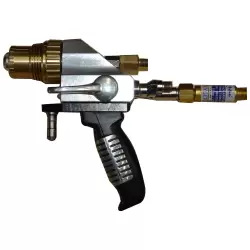
In order to improve the performance and lifespan of components, such as downhole equipment, high-velocity oxygen fuel (HVOF) coating is a specialized surface coating process that is often employed in numerous sectors, including oil and gas. Oil and gas wells are drilled and completed using downhole machinery.
In the HVOF process, a high-velocity oxygen stream and a fuel gas combination (often propane or hydrogen) are used to spray the selected coating material onto the surface of the downhole tool. A high-speed jet of hot gas is produced when the mixture is ignited in a combustion chamber, and it is this jet that drives the coating material onto the substrate surface. Typically, supersonic impacts produce coatings that are thick, well-bonded, and have little porosity.
Typically, metal, ceramic, or cermet (a mix of ceramic and metal) powders are used to create HVOF coating. The choice of coating material is determined by the particular application needs, such as thermal insulation, wear resistance, and corrosion resistance.
For downhole instruments subjected to abrasive and erosive pressures during drilling and well completion operations, HVOF coatings offer outstanding wear resistance. A lot of HVOF coatings have strong corrosion resistance, shielding downhole tools from the challenging conditions below ground when contact with corrosive fluids is frequent. HVOF coatings may occasionally operate as thermal insulators to assist control the heat produced during drilling and other downhole activities. Compared to uncoated tools, coated downhole tools often perform better, last longer, and require less maintenance.
Coating drill bits' essential components can increase their longevity and preserve cutting effectiveness. These instruments can be coated to withstand wear and keep their form in difficult downhole circumstances. The corrosion and wear resistance of valves and sealing components can be improved by coatings. These components can be coated to prevent corrosion and wear, especially in harsh well settings.
It might be difficult to guarantee uniform coating quality over intricate surfaces and geometries. Thermal spray coating may be brought on by the coating materials' high-velocity impact. To minimize this problem, proper material selection and process management are crucial. To obtain high adherence, surface preparation is essential prior to coating. Surface roughening and proper cleaning are required. Downhole tools with HVOF coatings perform much better, last longer, and endure harsher environments, which ultimately increases the effectiveness and success of oil and gas operations.
Known for their outstanding wear resistance, HVOF coatings are formed of high-density, well-bonded layers. While drilling through rock formations, downhole tools are subjected to abrasive and erosive pressures; the wear-resistant quality of HVOF coatings helps extend tool life and preserve cutting efficiency. Due to exposure to many chemicals and fluids, the downhole environment can be extremely corrosive. HVOF coatings can act as a barrier against corrosion, preventing surface deterioration and assuring the tool's continued efficacy over time.
In addition to wear, the movement of drilling fluids and rock fragments can induce erosion in downhole instruments. The thick and robust nature of HVOF coatings helps reduce erosion damage, maintaining the tool's integrity and performance. Some HVOF coatings are naturally thermally insulating. Thermal insulation can assist control heat produced during drilling in downhole applications where temperatures can fluctuate substantially and can also guard against heat-related wear and deterioration.
The surface hardness of downhole tools can be greatly increased by HVOF coatings. This improved hardness can offer higher resistance to impact, abrasive wear, and indentation, increasing the tool's useful life. Lower friction coefficients on coated surfaces can result in less heat being produced during frictional heating during drilling. This decrease in friction may also result in reduced tool wear and a need for less torque. Downhole tools' fatigue resistance can be improved with HVOF gun or coatings, enabling them to withstand cyclic loading and mechanical loads without breaking down too soon.
Downhole tools' dimensional stability can be kept through coatings, preserving crucial dimensions even in challenging working circumstances. HVOF coatings can be made to fit certain downhole tool specifications. Coatings may be chosen based on their wear resistance, corrosion resistance, thermal qualities, or a combination of these elements, depending on the application. HVOF coatings help to reduce downtime, which is essential for sustaining effective drilling operations by increasing the lifespan of downhole equipment and lowering the need for frequent replacements or repairs.